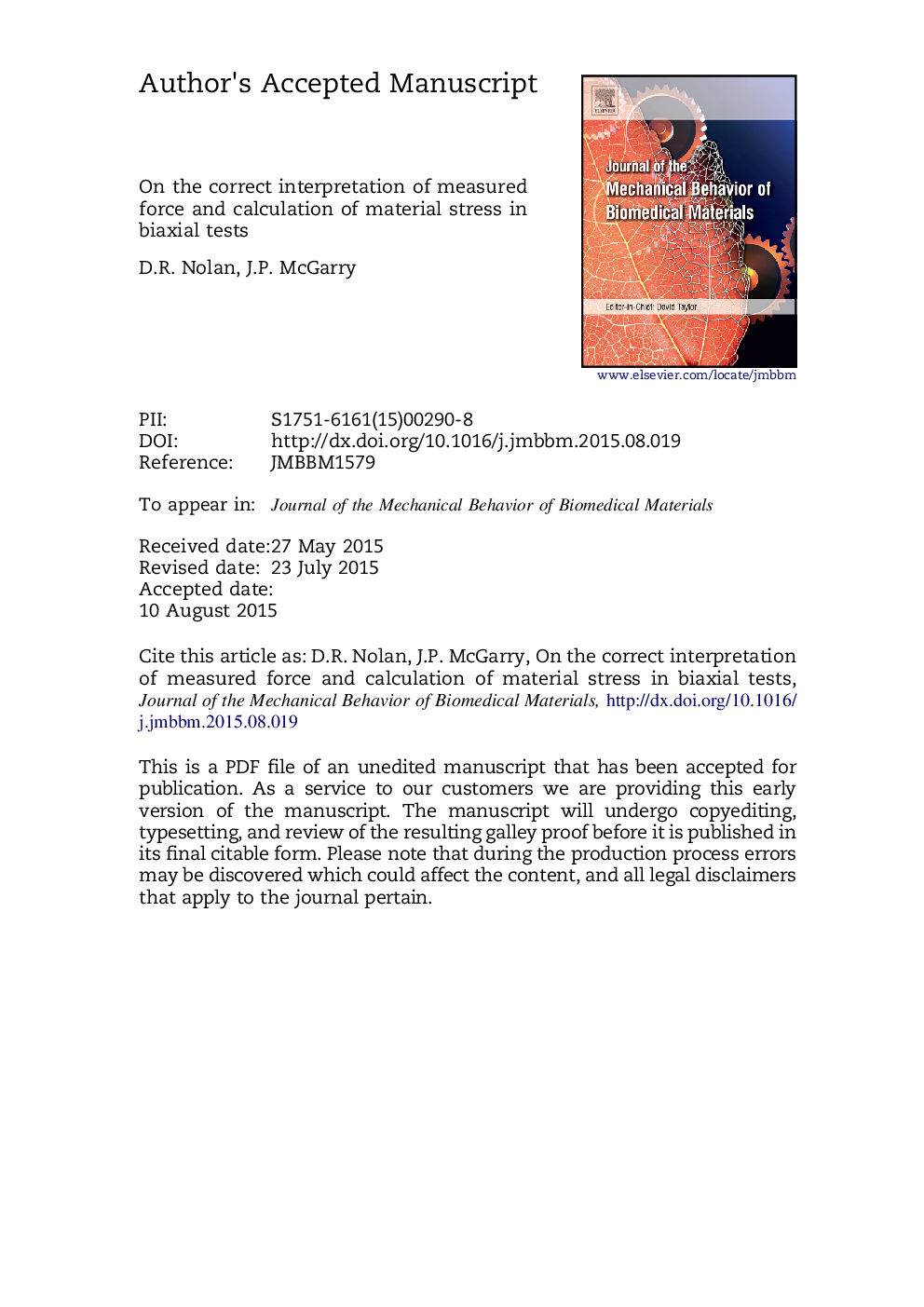| کد مقاله | کد نشریه | سال انتشار | مقاله انگلیسی | نسخه تمام متن |
|---|---|---|---|---|
| 7208324 | 1469092 | 2016 | 39 صفحه PDF | دانلود رایگان |
عنوان انگلیسی مقاله ISI
On the correct interpretation of measured force and calculation of material stress in biaxial tests
ترجمه فارسی عنوان
در تفسیر صحیح نیروی اندازه گیری شده و محاسبه تنش مواد در آزمون های دو اکسس
دانلود مقاله + سفارش ترجمه
دانلود مقاله ISI انگلیسی
رایگان برای ایرانیان
کلمات کلیدی
تست دو طرفه، استرس مواد، مواد غیر انعطاف پذیر، بافت نرم، هندسه نمونه، اثرات مرزی،
ترجمه چکیده
آزمونهای دو طرفه معمولا برای بررسی رفتار مکانیکی بافت و پلیمرهای نرم بیولوژیک استفاده می شود. در مقاله فعلی ما یک مشکل اساسی مرتبط با محاسبه استرس مواد از نیروی اندازه گیری در آزمون دو اکسسال استاندارد کشف کرده ایم. علاوه بر نیروهای اندازه گیری شده، نیروهای برشی غیرمنتظره محلی نیز در گیره ها رخ می دهد و عدم توانایی برای اندازه گیری چنین نیرویی معیارهای قابل توجهی برای محاسبه استرس مواد از روابط ساده نیروی تعادل است. نشان داده شده است که نیروهای برشی ناخواسته به علت دو مشارکت رقابتی متمایز بوجود می آیند: (1) نیروی برشی منفی به علت کشش گیره متعامد و (2) نیروی برشی مثبت در اثر اثر پواسون مواد. نیروی برشی گیره به شدت وابسته به هندسه نمونه و نسبت جابجایی گیره است، در نتیجه، رابطه نیروی - استرس اندازه گیری شده است. علاوه بر این در این مطالعه ما نشان می دهیم که فرمول های معمول پذیرفته شده برای تخمین تنش مواد در منطقه مرکزی یک نمونه کریستالی بسیار نادرست هستند. یک عامل تصحیح تجربی قابل اعتماد برای مورد کلی مواد مصنوعی باید از نظر هندسه نمونه و نسبت جابجایی گیره دو طرفه باشد. در نهایت ما نشان می دهیم که یک عامل تصحیح برای مورد کلی مواد غیر انحرافی غیر خطی امکان پذیر نیست و ما پیشنهاد استفاده از تجزیه عنصر محدود عناصر معکوس را به عنوان ابزار عملی تفسیر داده های تجربی برای چنین مواد پیچیده ای ارائه می دهیم.
موضوعات مرتبط
مهندسی و علوم پایه
سایر رشته های مهندسی
مهندسی پزشکی
چکیده انگلیسی
Biaxial tests are commonly used to investigate the mechanical behaviour of soft biological tissues and polymers. In the current paper we uncover a fundamental problem associated with the calculation of material stress from measured force in standard biaxial tests. In addition to measured forces, localised unmeasured shear forces also occur at the clamps and the inability to quantify such forces has significant implications for the calculation of material stress from simplified force-equilibrium relationships. Unmeasured shear forces are shown to arise due to two distinct competing contributions: (1) negative shear force due to stretching of the orthogonal clamp, and (2) positive shear force as a result of material Poisson-effect. The clamp shear force is highly dependent on the specimen geometry and the clamp displacement ratio, as consequently, is the measured force-stress relationship. Additionally in this study we demonstrate that commonly accepted formulae for the estimation of material stress in the central region of a cruciform specimen are highly inaccurate. A reliable empirical correction factor for the general case of isotropic materials must be a function of specimen geometry and the biaxial clamp displacement ratio. Finally we demonstrate that a correction factor for the general case of non-linear anisotropic materials is not feasible and we suggest the use of inverse finite element analysis as a practical means of interpreting experimental data for such complex materials.
ناشر
Database: Elsevier - ScienceDirect (ساینس دایرکت)
Journal: Journal of the Mechanical Behavior of Biomedical Materials - Volume 53, January 2016, Pages 187-199
Journal: Journal of the Mechanical Behavior of Biomedical Materials - Volume 53, January 2016, Pages 187-199
نویسندگان
D.R. Nolan, J.P. McGarry,
